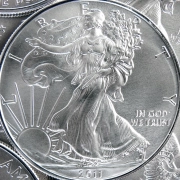Is Now a Good Time to Start Investing in Silver?
- What is Silver?
- What is the Long-Term Investment Outlook for Silver?
- Is now a good time to start investing in silver?
- How much does silver cost?
- Which Factors Influence the Price of Silver?
- Do You Have Silver In Stock?
What is Silver?
Pure silver is a chemical element with metallic properties. It can be found on the periodic table under the symbol “Ag”, which is short for argentum, the Latin word for “silver”. Silver is a soft, white, lustrous or “shiny” metal which makes it very desirable for uses in high quality jewelry.
Silver has been valued as a precious metal since antiquity. It can be found buried under the surface of the earth in it’s pure form, without the need for complex refinement processes prior to smelting, making it valuable to humans since prehistoric times.
Silver has been used a form of currency, finding application in numerous bullion coins, alongside gold and copper.
Silver is a versatile metal that finds its application in various art forms, including busts, sculptures, and figurines. It is also used to create ornamental household items like serving trays, vases, coffeepots, eating utensils, and cutlery. Additionally, silver is utilized in the production of handheld mirrors and musical instruments such as flutes.
Silver also possesses natural antibacterial properties and thus has applied medical uses such as surgical tools and bandages used to treat infections.
Silver is an excellent conductor of electricity making it very important in the manufacture of electronics.
What is the Long-Term Investment Outlook for Silver?
We can’t know for sure, but many investors are bullish on the long range speculation about the value of silver. They point out historical prices of silver and the overall supply and demand as indicators that influence their decisions.
The Great Silver Rush: Why 2023 Is the Year To Invest
As an investor, it’s important to always be on the lookout for new opportunities to grow your portfolio. And in 2023, one of the most compelling opportunities could be investing in silver.
Read more: https://t.co/8IG8bM2vsZ
— Ben Mumme (@mumme_ben) January 23, 2023
#RichDad Poor Dad author #RobertKiyosaki has urged investors to buy #silver before it’s gone, noting that it is getting more rare. https://t.co/E5FMbhg2ZO
— Bitcoin News (@BTCTN) August 15, 2023
Is now a good time to start investing in silver?
While it is impossible to predict what will happen to the price of silver in the future, there are several known factors that influence the price, and understanding these factors will help you determine where the price is headed in the near term. Silver, like gold, can be a strategic hedge against the volatility of other investments.
When governments print an excess of paper currency, the value of silver increases. Silver is often considered a safe refuge in times of heavy inflation. And when demand for silver increases from other uses such as electronics and medicine, the investment potential also increases. Consider the fact that silver is used in the production of Solar Panels. Due to the government mandates in states like California, where every new house that is built must have solar panels, by law, the value of silver can reasonably be expected to increase as demand rises.
If the global supply of silver increases due to mining exploration, however, the price can go down which will impact the value of silver as well. Buying silver is therefore not without an element of risk to investors. Careful caution and consideration must be taken when making any investment decision.
What are some of the most popular investment strategies that silver coin investors employ?
1. Buy and Sell
Many people who buy silver enjoy the fact that they can later sell the silver for cash if they ever need to. Other people try to buy and sell silver strategically in an effort to maximize their investment returns. A popular, but impossibly difficult strategy to perfect, is to attempt to “time the market”, which means you try to buy silver at a low price and wait patiently for the market price to rise. Then, at the exact moment of peak value, you sell the silver to extract the best possible return on your investment.
2. Buy and Hold.
Many disciplined and experienced investors claim the best strategy is to “buy and hold”: You buy the silver, and never sell it. This, of course, only works if the market has more increases in value than decreases over time, which, for silver, seems to be almost certainly the case.
3. Retirement Accounts.
Many investors are using an investment vehicle known as a Precious Metals IRA to store silver and other precious metals and bullions in their retirement accounts. Combining both gold and silver in your IRA can act as a powerful hedge against other assets and securities taking the form of stocks, bonds, cash, and real estate that are being saved for retirement.
What is a hedge?
A hedge is an investment strategy that acts as a failsafe by spreading the risk between primary and opposing positions. Think of the old adage “Don’t put all your eggs in one basket”. If all of your eggs are in one basket, and you accidentally drop it, all of your eggs might break. But if you put your eggs into two baskets, and one of the baskets is dropped, your other basket of eggs will be unharmed. You’ve spread your risk around, therefore decreasing the risk of losing all your eggs. This basket of eggs principle can be applied to investments and is known as “diversification”. A hedge takes the diversification strategy one step further by choosing a second investment (the “second basket”) that will likely increase if your primary investment decreases. If one of your investments goes down in value, your hedge is likely to go up, protecting you from a scenario where your investment portfolio as a whole becomes worthless.
How much does silver cost?
The price you pay for silver bullions will vary widely based on who is selling them. Most coin dealers will charge you a modest premium on top of the spot price. California Gold & Silver Exchange is widely known for offering some of the fairest premiums in the region, while other national companies will reportedly upcharge coin buyers more than 30%.
At the time of publication, the spot price of silver was $22.67 (USD). Compare that to 30 years ago, when an ounce of silver was trading at just $5, and held at that price steadily for more than a decade.

Following the economic collapse of 2008, the price of silver increased in value nearly 10 fold, not stabilizing until years later at around $15 per ounce. Similarly, the economic collapse following the COVID-19 pandemic drove the price up to double that amount.
Call us at (909) 985-4653 to check on pricing and the current inventory of silver bullions we have in stock today.
As mentioned in the “Are silver coins a good investment in 2023?” article, it seems likely that the demand for silver will continue to increase, driving up the price per ounce, making silver coins a very sensible addition to your investment portfolio.
Which Factors Influence the Price of Silver?
The price of silver is always fluctuating. In fact, every single second the price of silver updates based on several factors. Trading on the silver futures markets has the largest effect on the current price of silver. Other factors include:
- Newsworthy headlines in the financial and commodity markets
- Discoveries of new silver deposits (usually by mining companies) which increase the total supply of silver in the market.
- Fashion trends where silver jewelry becomes either more or less desirable.
- Geopolitical events
- Economic events
Do You Currently Have Any Silver In Stock?
Call us to check on the current inventory of silver bullions available today (909) 985-4653.










